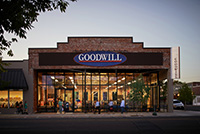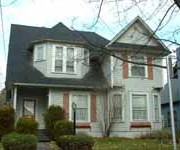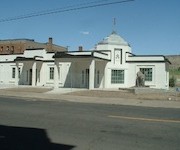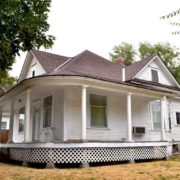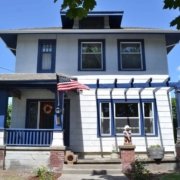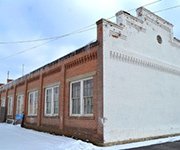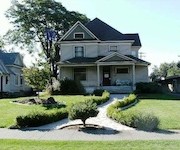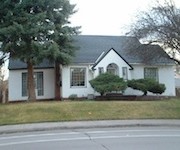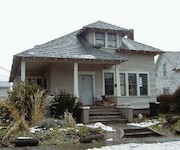History of 229 East Alder Street, Walla Walla, WA
Property Description:
Beginning at a point on the northerly line of Alder Street in the City of Walla Walla, which point is 153.50 feet easterly, measured along said northerly line of Alder Street, from the southwest corner of Block 1 of Robert’s Addition to the City of Walla Walla, according to the official plat thereof recorded in Volume A of Plats at page 21, records of Walla Walla County; thence north 60º10’ east, along said northerly line of Alder Street, a distance of 55.0 feet to the westerly line of Spokane Street; 120.0 feet; thence south 60º10’ west 55.0 feet; thence south 33º50’ east 120.0 feet to the point of beginning.
Title History:
Washington Territory was created in 1853. The new legislature created Walla Walla County in 1854 which stretched from the crest of the Cascade Mountains to the crest of the Rocky Mountains in present states of Washington, Idaho and Montana. In 1855 an Indian council was held on the banks of Mill Creek at the present site of Walla Walla to purchase land from the Indians. The Yakimas and Walla Wallas were unhappy with the treaties and prepared for war which followed. Missionaries, former French-Canadian employees of the Hudson Bay Company trading post at Wallula, and soldiers at Fort Walla Walla were the primary European occupants of the area prior to 1859 when it was opened for settlement. All of the land in this area was acquired from the Cayuse and Walla Walla Indian tribes by the U.S. Government in a treaty signed on June 9, 1855 in Walla Walla, and ratified on March 8, 1859 by President James Buchanan.
Walla Walla was originally laid out by surveyor H.H. Chase in 1859, even before its formal incorporation as a city in 1862, as a one-quarter mile square oriented N-S, E-W and with its eastern side centered on the point where Main Street crossed Mill Creek (at roughly the point where it does now). To this original area, additional parcels were annexed from time to time, usually named after the land owner of record at the time the additions were made.
This property have a very complicated legal history because it is at the junction of Cain’s Addition and Robert’s Addition with the northeast corner of original plat of Walla Walla. On September 10, 1861 Andrew J. Cain filed a claim for 160 acres under the Script Warrant Act of 1855 which included this property. A. J. Cain was an early financier of The Walla Walla Statesman newspaper; in 1868 he was elected on the Democratic ticket as prosecuting attorney of Walla Walla County. He later moved to Dayton and in September 1874 began publication of the Dayton News, a weekly Democratic newspaper. He became known as the “Father of Columbia County” as a result of his leading role in the formation of that county. The first local legal record for this property (and surrounding property) was a mortgage from A. J. Cain to A. H. and Lettice J. Reynolds on February 13, 1862.
A. H. Reynolds received a Sheriff’s Deed to 18 parcels including this property on March 1, 1864 for $1560. Almos H. Reynolds was born in New York state in 1808 and learned the millwright trade from his father. He came west to California in 1850 and to Walla Walla in 1859 where he lived until his death in 1889. He was held “in highest esteem” as one of Walla Walla’s leading citizens. He was associated with Dr. J. H. Day in establishing the first banking business in Walla Walla (see Reynolds-Day Building near Second and Main Streets) which led to the founding of the First National Bank. In 1861 he married Lettice J. Clark nee Millican who was the widow of Ransom Clark, who had come to Oregon with Fremont in 1843. Lettice and Almos had two sons Harry A. and Allen H. who both became prominent Walla Wallans. Another sheriff’s deed for 29 parcels that included some portion of this property was given to Dorsey S. Baker in 1867.
Some of this property was part of the 160 acre homestead claim of Alvin B. Roberts filed in the land office in Vancouver, Washington Territory. Roberts had visited this area as a soldier and brought his wife from Portland to settle in Walla Walla in 1859. Robert’s Addition was platted in 1871. On March 30, 1871 he sold a parcel measuring 157 feet by 272 feet to G. H. Reed and Philip L. Hawley for $300. On March 1, 1877 George H. Reed sold his undivided half of this same parcel to P. L. Hawley. Mr. Hawley died on May 20, 1877 and his wife Sarah Jane Hawley died on October 31, 1878. Their children, L. R., W. B., Thomas B., P. B., Henry H. and Sarah D. Hawley were the subsequent owners. On January 29, 1885 John F. and Sarah Boyer quit claimed to Dorsey Baker an undivided one third interest to this property which had legal title only in the name of Dorsey Baker. Dorsey and Elizabeth Baker quit claimed their interest in four parcels totaling 15,000 square feet to the City of Walla Walla on March 11, 1866. On June 1, 1889 the City gave a warranty deed to the six Hawley siblings. The first legal title for the current 55 feet by 125 feet lot was give on February 14, 1898 to W. B. and L. R. Hawley by their remaining siblings and their spouses. On January 30, 1907 all remaining family interests were transferred to William B. Hawley. On February 5, 1907 William B. and Stella Hawley sold the western portion of their 157 feet by 272 feet property to W. G. Preston, including the city assessment for the paving of Alder and Spokane Streets. On February 14, 1907 W. G. Preston et al signed a party wall agreement with L. R. Hawley. There were several legal actions that followed, including a quit claim deed from Ben C. and Edith Holt to J. Roulstone (1908), a deed from John D. and Alice Lamb to J. J. Roulstone (1909), and a quit claim deed from Ben C. and Ermine Holt to Leonard Sexton (1910 for $14,000). In 1911 Sarah E. Roulstone, executor and widow of John Roulstone sold her interest to Leonard Sexton.
On May 3, 1911 a Declaration of Trust was filed listing members of the trust as J. L. and Fannie S. Dumas, Sarah F. and Howard R. Keylor, H. C. and Emma Gregg, J. G. and Emily Frankland, George and Emma Brown, William and Marie Metz, William McCausland, bachelor. On November 24, 1911 Sexton sold his interest in this property (including a $7500 mortgage to Sarah Roulstone) to the George Brown Trust. On February 15, 1913 the George Brown Trust sold to H. R. Keylor subject to a lease from Ben Holt to Emery Corkrum and W. G. Corkrum. On July 1, 1919 H. R. and Sarah Keylor sold their interest to J. W. McCormmach. On July 22, 1920 J. W. and Laura B. McCormmach sold to the Franklin Sales Company including the 1907 party wall agreement. On July 12, 1921 S. S. Sayres, President of the Franklin Sales Co. sold this property to F. W. Bond for $$7,600. On June 7, 1923 F. W. and Ethel H. Bond sold an undivided half interest to Charles E. Bond. On March 3, 1928 F. W. and Charles Bond and their wives signed an agreement for deed with C. B. and Amanda F. Ruley for $18,000. Ruley’s first payment to the Bonds was to be a 5 passenger, 8 cylinder Paige automobile worth $2595. Numerous financing agreements followed until April 30, 1931 the bankruptcy trustee for Ruley Motor Co. sold this property to John Thonney for $13,000. On August 1, 1940 Eva Thonney, widow of John, gave a lease to The Texas Company of Los Angeles, CA which included a one story brick building with cut-under corner, 2 gas pumps, 3 storage tanks, 1 hoist and 1 compressor for $110/month. After two court cases a Referee’s Deed was given by W. L. Minnick, referee, to Clarence E. Hall on March 9, 1946. On the same day Clarence E. and Helen Elizabeth Hall signed a quit claim deed to Perry J. Brown. On February 1, 1968 Perry J. and Harriet L. Brown signed a warranty deed transferring this property t o Dennis and Cheryl Wagaman and Leo L. and Margaret E. Bogart. On July 30, 1969 Margaret E. Bogart, widow, sold her interest to Dennis and Cheryl E. Wagaman. The Wagamans leased some part of this space to the Walla Walla Community College for several years.
On April 9, 1975 a Purchaser’s Assignment of Contract and Deed was signed by Terrance W. and Janice Sue Teske in favor of Dennis Wagaman for $27,453.65 . There was a dissolution of marriage settlement in 1982 and numerous financing agreements until June 5, 2008 when Terry and Evelyne Teske sold this property to Chaucer Lane, LLC.
Occupant History:
On the 1905 fire map this property at the corner of Alder and Spokane Streets was identified as a “hay market” located south of the City Corporation Yard and City Pound. Spokane Street had been constructed but there was no bridge. In 1907 the owner of this property, L. R. Hawley, signed a party wall agreement with W. G. Preston. In 1908 Inland Auto moved from 44 E. Main to Alder and Spokane Streets. John E. Lamb was the owner/manager of the business. Cars sold by the company were the Franklin, E-M-F and Studebaker. E-M-F contracted with the Studebaker Corporation to sell their cars though Studebaker wagon dealerships. Detractors said the E-M-F name meant “Every Morning Fix-it” A repair shop located here was run by E. W. Corkrum. By 1910 Inland Auto was not listed in the city directory but Franklin Repair still operated here. In 1911 the Franklin Motor Car Company was operated here by Ralph H. Tuttle. He sold Franklin and Dodge cars. The Franklin was the first “dependable” gasoline-powered car that had arrived in Walla Walla in 1905. By 1918 the city directory listed only the Franklin Repair Shop operated by Fred Parent at 225 E. Alder, an address used for this property. However, in 1920 the Franklin Sales Company was here with J. W. McCormmach, president and S. S. Sayers as vice president and manager. In 1921 they moved to Alder and Colville and Davin-Horn Company was at 225 E. Alder. Saraphin V. Davin and R. H. Horn operated Chalmers Sales and Service here. Chalmers cars had flourished in the 1910s and then faltered in the 1920s post-World War I recession. The company merged with the Maxwell Automobile Company in the early 1920s, and ended all production in late 1923. By 1923 Mr. Davin was listed as a farmer and Mosely Sales Company was located here selling wholesale tires. In 1926 the McLoughlin Auto Company was selling Studebaker cars here. In 1931 the Garden City Wrecking House was operated by George W. Kelty at this location. In 1935 Huff Brothers Trucking was operated here by Harlan A. Huff. In 1939 Roy D. Anderson opened an auto repair shop here. He was joined by Floyd Kerslake in 1941. In 1946 the Central Grocery Company was operated here by Jas. C. Murrills, manager. In 1948 Columbia Wholesale Grocery Corp. was operated by Amos. W. Perkins and Ralph Glafke here. In 1953 there appeared two new addresses at this location. Myers Radio and TV Repair was at 229 E. Alder and Perry J. Brown’s Walla Walla City Bus Line garage was at #231. Harold J. Myers operated his radio and television repair shop here until 1967. The City Bus Line operated here until 1958, at which time it moved to 3 South Third. The #231 address did not appear in subsequent city directories. In 1968 Zentner Walla Walla Upholstery was operated here by Leo Bogard and Dennis Wagaman as partners. Starting in 1974 Walla Walla Upholstery was operated here by Terry Teske, owner/manager, continuing at least until city directories ceased publication in 2000.
Construction of the Building:
The Walla Walla County Assessor’s Office records list the “year built” as 1930. This is 23 years too late as documented by the legal title, the occupants listed in city directories and photographs as early as 1908. The only building permit issued for this property was to L. R. Hawley in 1912 to “move building” for $40. The party wall agreement in 1907 and the location of Inland Auto here in 1908 clearly suggest that this building was constructed in 1907, prior to the commencement of building permit records in September of that year, by owner Livingston R. Hawley.
References:
Bennett, Robert A., Walla Walla Portrait of a Western Town 1804-1899, Pioneer Press, Walla Walla, 1980.
Bennett, Robert A., Walla Walla A Town Built to be a City 1900-1919, Pioneer Press, Walla Walla, 1982.
Bennett, Robert A., A Nice Place to Raise a Family 1920-1949, Pioneer Press, Walla Walla, 1988
Building Permits: Whitman College Penrose Library Archives.
Lyman, Professor W. D., An Illustrated History of Walla Walla County 1901.
Lyman, Professor W. D., Lyman’s History of Old Walla Walla County, Vol. 1-2, 1918.
Sanborn Fire Maps: 1884-1905 (with updates until 1954).
Walla Walla City Directories: 1880-2000 (various publishers–not all years).
Walla Walla County Assessor’s Office
Whitman College Archives.
Up-to-the-Times Magazine
Mary E. Meeker ; Walla Walla 2020 Research Service PO Box 1222, Walla Walla WA 99362 August, 2008

